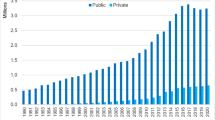Abstract
The Educational Amendments of 1972 marked a new direction in public policy regarding the scope and purpose of financial aid to higher education. Aid became more “student-oriented,” and equality of opportunity for higher education became a goal. This empirical study with national longitudinal data has made a start in policy evaluation of the effect of the 1972 Educational Amendments on the higher education acquired by young women. The most important result of financial aid receipt for young women is that those who received aid averaged 0.64 more years completed of higher education and averaged .145 greater graduation probability than similar women who did not receive aid. These results were obtained in multiple regression models in which the effects of marital status, parental background, geographic locations and economic characteristics, and tuition level were controlled for. These results suggest that policy attempts to stimulate the higher education acquired by enrolled young women by increasing the availability of financial aid are well founded.
Similar content being viewed by others
References
Bragg, Stephen M. The relationship between student interstate migration and financial aid practices and policies. Unpublished doctoral dissertation, The Pennsylvania State University, 1980.
Carnegie Council on Policy Studies in Higher Education.Next Steps for the 1980's in Student Financial Aid. San Francisco: Jossey-Bass, 1979, Table 6.
Gladieux, L., and Wolanin, T.Congress and the Colleges. Lexington, Mass.: Lexington Books, 1979.
Goodman, J. L., Jr. Is ordinary least squares with a dichotomous dependent variable really that bad? Working Pager 216-23. Washington, D.C.: Urban Institute, 1976.
Neter, J., and Wasserman, W.Applled Linear Statistical Models. Homewood, Ill.: Richard D. Irwin, Inc., 1974.
Heckman, J. Sample bias and a source of specification error.Econometrica January 1979,47 153–61.
Rosen, S. Human capital: a survey of empirical research. In R. Ehrenberg (ed.),Research in Labor Economics. (Vol. 1) Greenwich, Conn.: JAI Press, 1977.
Tierney, M. L. The impact of financial aid on student demand for public/private higher education.Journal of Higher Education 1980,51 527–45.
Willis, R. J., and Rosen, S. Education and self selection.Journal of Political Economy, Supplement, October 1979.
Author information
Authors and Affiliations
Rights and permissions
About this article
Cite this article
Stephenson, S.P., Eisele, T.W. The impact of financial aid on women's demand for higher education. Res High Educ 17, 345–361 (1982). https://doi.org/10.1007/BF00977902
Received:
Issue Date:
DOI: https://doi.org/10.1007/BF00977902




